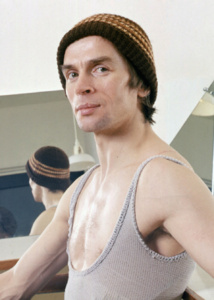Nureyev's legacy in spotlight, 20 years on
Marie-Pierre Ferey
PARIS, Marie-Pierre Ferey- Twenty years after his death, Rudolf Nureyev's legacy still lights up the world of ballet as brilliantly as the flamboyant performances which once illuminated the greatest stages.
"As long as they are putting on my ballets, I will live on," Brigitte Lefevre, dance director of the Paris Opera, recalls Nureyev saying in the years before the ravages of AIDS finally claimed him, aged 54, on January 6, 1993.

Photo by Allan warren; image accessed via Wikipedia.
"He redefined the role of the male dancer," said ballet historian Helene Ciolkovitch. "He took it beyond that of simple support, creating a more balanced partnership with the ballerina."
"When you danced alongside him, you really had to give everything. If you didn't you couldn't keep up," recalled Noella Pointois, one of Nureyev's numerous celebrated on-stage partners. "It was a huge thing, dancing with a star like him."
Nureyev was also famously demanding as a director. "He made it tough for dancers," smiles Lefevre in a reference to the enhanced variation and tempo that are characteristic of Nureyev's productions.
In his six years (1983-89) as dance director at the Paris Opera, he bequeathed to the world his own versions of the major works of Marius Petipa, the 19th-century creator of "Don Quixote", "Sleeping Beauty", "La Bayadere" and countless other standbys of the ballet repertory.
"He took these pieces that had been created in Russia and updated them using modern choreographic technique, without breaking with their classical roots," said Ciolkovitch.
-- 'A posthumous homecoming' --
The only son of a Red Army official, Nureyev was famously born, in 1938, on the Trans-Siberian express while his mother was en route to visit her husband in the Siberian port of Vladivostock.
His passion for dance, and ballet in particular, was born at the age of six and he went on to become one of the former Soviet Union's best-known artists as the leading dancer of the Kirov ballet in Leningrad -- as St Petersburg was then known.
With such status came the freedom to travel and Nureyev made the most of it, applying the same energetic approach that made him such a charismatic performer to getting the most out of the nightlife on offer in Paris and London.
His increasingly high profile did not go down well with the communist authorities and, having been ordered back to Moscow from a Kirov tour in 1961, he decided not to get on the plane, instead pleading, successfully, to be granted political asylum.
The French authorities complied but it was Britain that saw the best of Nureyev as a dancer, most famously in his legendary partnership with Margot Fonteyn at the Royal Opera House.
Off-stage, Nureyev had a long term relationship with the Danish dancer Erik Bruhn, who died in 1986. But according to Pontois, he was, essentially, a solitary character.
"He had been obliged to abandon his family (in the Soviet Union)," she recalled. "That left him with a lot of guilt, it was a heavy burden."
Having successfully hidden the extent of his illness for some time, Nureyev effectively announced it to the world when he appeared, gaunt and frail, at a premiere of "La Bayadere" two months before his death.
"It is always hard when someone doesn't know when to leave the stage, but for him it really was a question of life or death," said Pontois. "He dedicated his life to dance."
Ballet companies around the world are paying tribute to the dancer two decades after his death.
The Paris Opera hosts a gala night on Sunday, with his "Sleeping Beauty" running as part of its 2013/2014 season and his "Nutcracker" in 2014/2015.
London's Royal Ballet this month stages Nureyev's "Raymonda", followed next month by "Marguerite and Armand", while the Vienna Opera ballet plans a Nureyev gala on June 29 and San Francisco's De Young Museum is showcasing his stage costumes until February.
And come September the Kremlin ballet will perform his "Cinderella" -- a milestone for Russia, where authorities stung by his defection blacked out all information about him even as his international career soared.
A posthumous homecoming for Nureyev, who had returned to his native land after 26 years in exile, only to find his ailing mother did not recognise him, and the Russian public knew nothing of his stellar rise.
-----------------------------------------------------------------------------------------------------